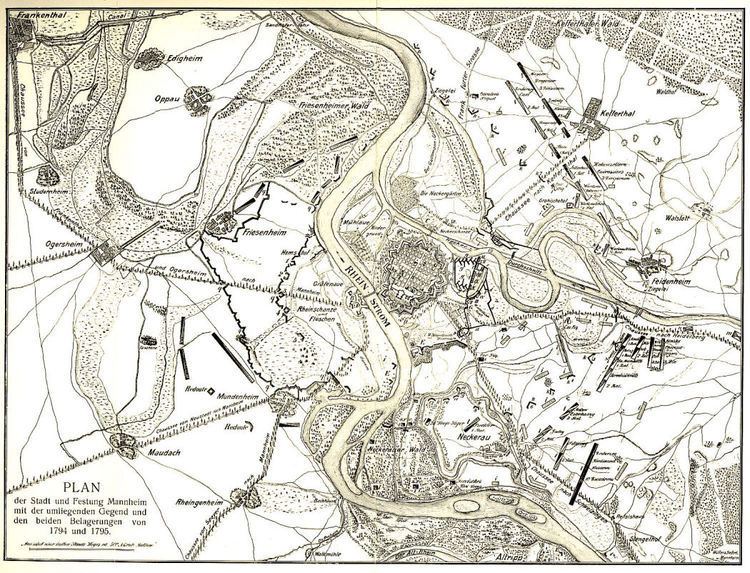Battle 2,000, 3 guns
Siege 10,000 Battle 709
Siege 400 Location Mannheim, Germany | Result Austrian victory | |
 | ||
Battle 12,000
Siege 10,000 Battle 17,000
Siege 25,000 Similar Siege of Fort‑Louis, Siege of Collioure, Battle of Gosselies, Siege of Ypres, Battle of Collioure | ||
The Siege of Mannheim (18 October – 22 November 1795) began when 17,000 Habsburg Austrian troops under Dagobert Sigmund von Wurmser defeated 12,000 Republican French soldiers led by Jean-Charles Pichegru. In the Battle of Mannheim the French were driven from their camp and forced to retreat into the city of Mannheim which was then placed under siege. After winning battles at Mainz and Pfeddersheim, the Austrian army of François Sébastien Charles Joseph de Croix, Count of Clerfayt drove Pichegru's army away from the city, leaving it isolated. After a month-long siege, the 10,000-strong Republican French garrison of Anne Charles Basset Montaigu surrendered to 25,000 Austrians commanded by Wurmser. This event brought the 1795 campaign in Germany to an end. The battle and siege occurred during the War of the First Coalition, part of the French Revolutionary Wars. Situated on the Rhine River at its confluence with the Neckar River, Mannheim lies in the state of Baden-Württemberg in modern-day Germany.
Campaign of 1795
In the summer of 1795, the French Directory ordered General of Division Jean-Baptiste Jourdan with the Army of Sambre-et-Meuse and General of Division Jean-Charles Pichegru with the Army of Rhin-et-Moselle to launch a pincer attack across the Rhine against Feldmarschall Count of Clerfayt's Austrian army. Jourdan was instructed to cross to the north near Düsseldorf while Pichegru crossed anywhere between Mannheim and Strasbourg in the south. Jourdan's army crossed the Rhine north of Düsseldorf on 8 September. Wheeling to the right, the Army of Sambre-et-Meuse struck south and moved forward to the Lahn River by 20 September. On the 21st, the Bavarian garrison at Düsseldorf capitulated to General of Division François Joseph Lefebvre and 12,600 French troops. Count Hompesch's 2,000-man garrison was allowed to march home after promising not to fight the French for one year. The city and its 168 fortress guns became French prizes. In the south Pichegru found his army blocked by General der Kavallerie Dagobert Sigmund von Wurmser's Austrian army. Pichegru moved north until he was across from Mannheim and demanded its surrender. Baron von Belderbusch entered into negotiations with the French and surrendered Mannheim and 471 guns on 20 September. His 9,200-man Bavarian garrison was allowed to march home. The Austrians felt betrayed by their allies, but could only protest as their enemies gained a key bridgehead.
